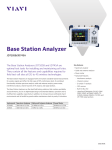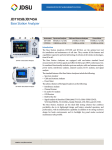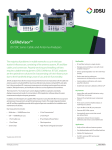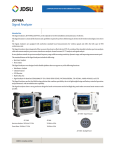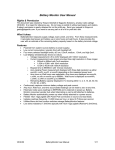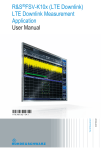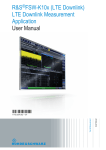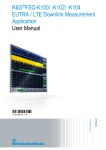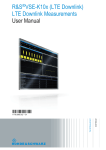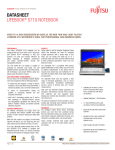Download JD745A
Transcript
COMMUNICATIONS TEST & MEASUREMENT SOLUTIONS JD745A Base Station Analyzer Spectrum Analyzer: 100 kHz to 4 GHz Cable and Antenna Analyzer: 5 MHz to 4 GHz Power Meter: 10 MHz to 4 GHz Specification Conditions The JD745A specifications apply under the following conditions. • After instrument has been turned on for at least 15 minutes. • The instrument is operating within a valid calibration period. • Data with no tolerance is considered as typical values. • The ‘typical’ or ‘nominal’ values are defined as follows: –– Typical: Expected performance of the instrument operating under 20 to 30°C after being at this temperature for 15 minutes. –– Nominal: A general, descriptive term or parameter. *All specifications subject to change without notice. Spectrum Analyzer (Standard) JD745A Frequency range 100 kHz to 4 GHz Internal 10 MHz Frequency Reference Accuracy ±0.05 ppm (25°C ±25°C) + aging Aging ±0.5 ppm per/year Frequency Span Range Resolution 0 Hz (zero span) 10 Hz to 4 GHz 1 Hz Resolution Bandwidth (RBW) –3 dB bandwidth Accuracy 1 Hz to 3 MHz 1-3-10 sequence ±10% (nominal) Video Bandwidth (VBW) –3 dB bandwidth Accuracy 1 Hz to 3 MHz 1-3-10 sequence ±10% (nominal) Single Sideband (SSB) Phase Noise RBW 10 kHz, VBW 1 kHz, RMS detector Carrier offset: 30 kHz ≤90 dBc/Hz 100 kHz ≤95 dBc/Hz 1 MHz ≤102 dBc/Hz WEBSITE: www.jdsu.com/test Typical JD745A BASE STATION ANALYZER 2 Measurement Range DANL to +20 dBm Input attenuator range Maximum Input Level Average continuous power DC voltage Markers Marker types Linear scale and units Detectors Number of traces Trace functions RF Input VSWR 1.5:1 20 MHz to 4.0 GHz Typical +20 dBm ±50 VDC Displayed Average Noise Level (DANL) 1 Hz RBW, 1 Hz VBW, 50 Ω termination, 0 dB attenuation, RMS detector Preamplifier Off: 10 MHz to 2.3 GHz –140 dBm >2.3 to 3.0 GHz –138 dBm >3.0 to 4.0 GHz –135 dBm Preamplifier On: 10 MHz to 2.3 GHz –155 dBm >2.3 to 3.0 GHz –153 dBm >3.0 to 4.0 GHz –150 dBm Display Range Log scale and units Number of markers Marker functions Normal, delta, delta pair noise, frequency count marker 6 Peak, next peak, peak left, peak right, minimum search marker to center/start/stop 0 to 50 dB, 5 dB steps 1 to 20 dB/division in 1 dB steps 10 divisions displayed dBm, dBV, dBmV, dBµV 10 divisions displayed V, mV, mW, W Normal, positive peak, sample, negative peak, RMS 6 Clear/write, maximum hold, minimum hold, capture, load View On/Off Total Absolute Amplitude Accuracy Preamplifier off, power level > –50 dBm, auto coupled (25°C ±5°C) 5 MHz to 4 GHz ±1.25 dB, ±0.5 dB (typical) Attenuation < 40 dB ±1.55 dB, ±1.0 dB (typical) Attenuation ≥ 40 dB Second Harmonic Distortion (Second Harmonic Intercept: SHI) Mixer level = –25 dBm 10 MHz to 1.3 GHz < –65 dBc Typical 1.3 to 4.0 GHz < –70 dBc Typical Third-order Inter-modulation (Third-order Intercept: TOI) 200 MHz to 2 GHz +10 dBm Typical 2 to 4 GHz +12 dBm Typical Spurious Inherent residual response Input terminated, 0 dB attenuation, preamplifier off, RBW at 10 kHz 20 MHz to 3 GHz –90 dBm Nominal 3 to 4 GHz –85 dBm Nominal Exceptions < –85 dBm at 2497.8 and 1599.0 MHz Input related spurious < –70 dBc Dynamic Range > 95 dB Sweep Time Range Sweep mode Reference Level Setting range Setting resolution Log scale Linear scale –120 dBm to +100 dBm 0.1 dB 1% of reference level Gated Sweep Trigger source Gate length Gate delay Trigger Trigger source Trigger delay Range Resolution 2/3 (TOI-DANL) in 1Hz RBW 80 ms to 1000 s 24 µs to 200 s Continuous, single Span = 0 Hz (zero span) External 1 µs to 100 ms 0 to 100 ms Free run, video, external 0 to 200 s 6 µs JD745A BASE STATION ANALYZER 3 Measurements Spectrum analysis with CW signal generator Channel power Occupied bandwidth Spectrum emission mask Adjacent channel power Spurious emissions Field strength AM/FM audio demodulation Measurements Reflection (VSWR) VSWR range Return loss range Resolution Distance to Fault (DTF) Vertical VSWR range Vertical return loss range Vertical resolution Horizontal range Cable and Antenna Analyzer (Standard) General Parameters Range Resolution Accuracy Data Points 126, 251, 501, 1001 Measurement speed 1 Port measurements Horizontal resolution 5 MHz to 4 GHz 10 kHz ±25 ppm 1.65 ms/point Nominal Measurement Accuracy Corrected directivity 40 dB (typical) Reflection uncertainty 0.3 + |20log (1+10-EP/20)| EP = Directivity – Measured return loss Output Power High Low Dynamic Range Reflection Maximum Input Level Average continuous power DC voltage Interference immunity +0 dBm –30 dBm Typical Typical 60 dB +25 dBm ±50 VDC +17 dBm on channel 0 dBm on frequency Nominal Nominal Cable Loss (1 port) Range Resolution 1-port Phase Range Resolution Smith Chart Resolution 1 to 65 0 to 60 dB 0.01 1 to 65 1 to 60 dB 0.01 0 to (# of data points – 1) x horizontal resolution (1.5x108)x(Vp)/ (Delta)x(0.95) Maximum = 1500 m (4921 ft) Vp = Propagation velocity Delta = Stop Freq – Start Freq [Hz] 0 to 30 dB 0.01 dB –180° to +180° 0.01° 0.01 Power Meter (Standard) General Parameters Display range Offset range Resolution –100 to +100 dBm 0 to 60 dB 0.01 dB or 0.1xW Internal Power Sensor Frequency range Span Dynamic range Maximum power Accuracy 10 MHz to 4 GHz 100 kHz to 100 MHz –120 to +20 dBm +20 dBm Same as spectrum analyzer x = m, u, p JD745A BASE STATION ANALYZER 4 External Power Sensors Directional power sensors Frequency range Dynamic range Connector type Measurement type Accuracy JD731A JD733A 300 to 3800 MHz 150 to 3800 MHz Average 0.15 to 150 W Average Peak 4 to 400 W Peak Type N (f ) on both ends Forward/reverse average power, forward peak power, VSWR ±4% + 0.05 W1 Terminating power sensors Frequency range Dynamic range Connector type Measurement type Accuracy JD732A 20 to 3800 MHz –30 to 20 dBm Type N (m) Average ±7%1 Optical power meter Display range –100 to +100 dBm Offset range Resolution 0 to 60 dB 0.01 dB or 0.1 mW External optical power sensors Optical power sensors Wavelength range Max permitted input level Connector input Accuracy CW condition at 25°C ±10°C 1 MP-60 +10 dBm Universal 2.5 and 1.25 mm connectors JD734A 20 to 3800 MHz –30 to 20 dBm Type N (m) Peak ±7%1 0.1 to 50 W 0.1 to 50 W JD736A 20 to 3800 MHz –30 to 20 dBm Type N (m) Average and peak ±7%1 MP-80 780 to 1650 nm +23 dBm ±5% JD745A BASE STATION ANALYZER 5 2-Port Transmission Measurements (Option 001) Frequency Frequency range Frequency resolution GPS Receiver and Antenna (Option 010) GPS Indicator Latitude, Longitude, Altitude 5 MHz to 4 GHz 10 kHz High-frequency Accuracy Output Power High Low Measurement Speed 2.2 ms/point Dynamic Range Vector: Scalar: Measurements Insertion Loss/Gain Range Resolution 2-port Phase Range Resolution 0 dBm –30 dBm Typical Typical Spectrum, interference, and signal analyzer GPS lock Hold over Connector ±25 ppb ±50 ppb SMA, female 15 minutes after locking to GPS Nominal Interference Analyzer (Option 011) 5 MHz to 3 GHz, 80 dB > 3 to 4 GHz, 75 dB 5 MHz to 4 GHz >100 dB –120 to 100 dB 0.01 dB –180° to +180° 0.01° Measurements Spectrum analyzer Spectrogram RSSI Sound indicator, AM/FM audio demodulator, interference ID, spectrum recorder Collect data up to 72 hours Collect data up to 72 hours Received signal strength indicator Interference finder Spectrum player Channel Scanner (Option 012) Frequency Range 100 kHz to 4 GHz Bias Tee (Option 002) Voltage Voltage range Voltage resolution Power 8 W Max +12 to +32 V 0.1 V 10 MHz to 4 GHz CW Signal Generator (Option 003) Frequency Frequency range Frequency reference Frequency resolution 25 MHz to 4 GHz < ±25 ppm 10 kHz Output Power Range Step Accuracy 0 dBm, –30 to –80 dBm 1 dB ±1.5 dB Measurement Range –110 to +20 dBm Measurements Channel scanner Frequency scanner Custom scanner 1 to 20 channels 1 to 20 frequencies 1 to 20 channels or frequencies JD745A BASE STATION ANALYZER 6 GSM/GPRS/EDGE Signal Analyzer (Option 022) General Parameters Frequency range Input signal range Burst power Frequency error GMSK modulation quality Phase RMS accuracy Residual error Phase peak accuracy 8 PSK modulation quality EVM accuracy Residual error RF power vs time 450 to 500 MHz 820 to 965 MHz 1705 to 1995 MHz –40 to +20 dBm ±1.0 dB ±10 Hz + ref freq accuracy ±1.0 degrees 99% Confidence level (0 < Phase RMS < 8) 0.7 degrees ±2.0 degrees ±1.5% Typical (0 < Phase peak < 30) (2% < EVM < 8%) 2.5% ±0.25 symbol Measurements Channel power Channel power Spectral density Peak to average power Occupied bandwidth Occupied bandwidth Integrated power Occupied power Spectrum emission mask Reference power Peak level at defined range Spurious emissions Peak frequency at defined range Peak level at defined range Option 022 Power vs. time (Slot) Burst power Max/Min point Power vs. time (Frame) Frame average power Burst power (Slot 0 to 7) TSC (Slot 0 to 7) Constellation Burst power Modulation type Frequency error Phase error RMS Phase error peak IQ origin offset* TSC BSIC C/I* EVM RMS* EVM Peak* EVM 95th* Auto measure Channel power Occupied bandwidth Spectrum emission mask Burst power Frame average power PvsT – Mask Frequency error Phase error RMS Phase error peak EVM RMS* EVM Peak* IQ origin offset C/I* * The measurements are performed for 8 PSK modulation signals (EDGE) only. Longitude, latitude, and satellite in all screens Option 042 Channel scanner Frequency scanner Absolute power Group (Traffic, Control) BSIC (NCC, BCC) Multipath profile (Ten strongest) Frame average power SNR, delay Modulation analyzer Frame avg power trend C/I trend Frame average power BSIC, frame No. and time C/I, frequency error Burst power Modulation type JD745A BASE STATION ANALYZER 7 WCDMA/HSDPA Signal Analyzer (Option 023 for WCDMA, Option 024 for HSDPA) General Parameters Frequency range Input signal range RF channel power accuracy Occupied bandwidth accuracy Adjacent channel leakage ratio (ACLR) WCDMA modulation HSDPA modulations Frequency error EVM accuracy Residual EVM Code domain power CPICH accuracy (dBm) Band I to Band XIV –40 to +20 dBm ±1.0 dB, ±0.7 dB (typical) ±100 kHz < –56 dB, ±0.7 dB at 5 MHz offset < –58 dB, ±0.8 dB at 10 MHz offset QPSK QPSK, 16 QAM, 64 QAM ±10 Hz + ref freq accuracy ±2.0%, 2% ≤ EVM ≤ 20% 2.5% ±0.5 dB relative power ±1.5 dB absolute power ±0.8 dB 99% Confidence level Typical Code channel power > –25 dB Typical Measurements Channel power Channel power Spectral density Peak to average power Occupied bandwidth Occupied bandwidth Integrated power Occupied power Spectrum emission mask Reference power Peak level at defined range ACLR Reference power Abs power at defined range Rel power at defined range Multi-ACLR Lowest reference power Highest reference power Abs power at defined range Rel power at defined range Spurious emissions Peak Freq at defined range Peak Level at defined range Option 023 and 024 Constellation Auto measure CPICH power Channel power Rho, EVM Occupied bandwidth Peak CDE Spectrum emission mask Frequency error ACLR Time offset Multi-ACLR Carrier feed through Frequency error Scramble Code EVM Code domain power Peak CDE Abs/Rel code power Carrier feed through Individual code EVM, CPICH absolute power Constellation CPICH relative power Channel power Max inactive power Power bar graph (Abs/Rel/delta power) Power statistics CCDF CPICH, PCCPCH, SCCPCH PICH, P-SCH, S-SCH Max, avg active power Max, avg inactive power Scramble code Codogram Code utilization RCSI CPICH, P-CCPCH, S-CCPCH, PICH, P-SCH, S-SCH CDP table Code utilization Code, spreading exactor Allocation (channel type) EVM, modulation type Relative, absolute power Longitude, latitude, and satellite in all screens Option 043 Channel scanner (up to 6) Frequencies or channels Channel power, scramble Code, CPICH power, Ec/Io Scramble scanner (up to 6) Channel power CPICH dominance Scramble code Ec/Io, CPICH power, delay Multipath profile Channel, multipath power Ec/Io, delay Code domain power Abs/Rel code power Individual code EVM Channel power Scramble code CPICH, PCCPCH, SCCPCH, PICH, P-SCH, S-SCH power Max, avg active power Max, avg inactive power Frequency error Time offset, Rho Carrier feed through (Composite) EVM CPICH EVM, P-CCPCH EVM Amplifier capacity Peak amplifier capacity Average amplifier capacity Code, peak utilization Average utilization JD745A BASE STATION ANALYZER 8 cdmaOne/CDMA2000 Signal Analyzer (Option 020) General Parameters Frequency range Input signal level RF channel power accuracy CDMA compatibility Frequency error Rho accuracy Residual Rho PN offset Code domain power Pilot power accuracy Time offset Band 1 to Band 10 –40 to +20 dBm ±1.0 dB cdmaOne and CDMA2000 ±10 Hz + ref freq accuracy ±0.005, 0.9 < Rho < 1.0 >0.995 1 x 64 chips ±0.5 dB relative power ±1.5 dB absolute power ±1.0 dB ±1.0 μs, ±0.5 μs (typical) Typical 99% Confidence level Typical External trigger Measurements Channel power Channel power Spectral density Peak to average power Occupied bandwidth Occupied bandwidth Integrated power Occupied power Spectrum emission mask Reference power Peak level at defined range ACPR Reference power Abs power at defined range Rel power at defined range Multi-ACPR Lowest reference power Highest reference power Abs power at defined range Rel power at defined range Spurious emissions Peak freq at defined range Peak level at defined range Option 020 Constellation Pilot power Rho EVM Frequency error Time offset Carrier feed through Pn offset Code domain power Abs/Rel code power Channel power Power bar graph (Abs/Rel) Pilot, sync Page, Q-page Max, avg active power Max, avg inactive power PN offset Codogram Code Utilization RCSI Pilot, paging, sync, Q-page CDP table Code utilization Code, spreading factor Allocation (channel type) Relative, absolute power Auto measure Channel power Occupied bandwidth Spectrum emission mask ACLR Multi-ACLR Rho Frequency error Time offset Carrier feed through Pilot power Max inactive power Power statistics CCDF Longitude, latitude, and satellite in all screens Option 040 Channel scanner (up to 6) Frequencies or channels Channel power, PN offset Pilot power, Ec/Io PN scanner (up to 6) Channel power Pilot dominance PN offset Ec/Io, pilot power, delay Multipath profile Channel power Multipath power Ec/Io, delay Code domain power Abs/Rel code power Channel power Pn offset Pilot, sync power Page, Q-page power Max, avg active power Max, avg inactive power Frequency error Time offset, Rho, EVM Carrier feed through Amplifier capacity Peak amplifier capacity Average amplifier capacity Code, peak utilization Peak utilization Average utilization JD745A BASE STATION ANALYZER 9 EV-DO Signal Analyzer (Option 021) General Parameters Frequency range Input signal level RF channel power accuracy EV-DO compatibility Frequency error Rho accuracy Residual Rho PN offset Code domain power Pilot power accuracy Time offset Band 1 to Band 10 –40 to +20 dBm ±1.0 dB Rev 0, Rev A and Rev B ±10 Hz + ref freq accuracy ±0.005, 0.9 < Rho < 1.0 >0.995 1 x 64 chips ±0.5 dB relative power ±1.5 dB absolute power ±1.0 dB ±1.0 μs, ±0.5 μs (typical) Typical 99% Confidence level Typical External trigger Measurements Channel power Channel power Spectral density Peak to average power Occupied bandwidth Occupied bandwidth Integrated power Occupied power Spectrum emission mask Reference power Peak level at defined range ACPR Reference power Abs power at defined range Rel power at defined range Multi-ACPR Lowest reference power Highest reference power Abs power at defined range Rel power at defined range Spurious emissions Peak frequency at defined range Peak level at defined range Option 021 Power vs. time MAC codogram (idle and active slot) Code utilization Slot average power RCSI On/Off Ratio Slot, pilot, MAC, data Idle activity MAC CDP table Pilot, MAC, data power Code utilization Constellation Code, spreading factor (Composite 64/128, pilot, Allocation (channel type) MAC 64/128, data) Relative, absolute power Channel power Rho, EVM Auto measure Peak CDE Channel power Frequency error Occupied bandwidth Time offset Spectrum emission mask Carrier feed through ACLR PN offset Multi-ACLR Data modulation type* Pilot, MAC, data power Code domain power On/Off ratio (Pilot and MAC 64/128) Pvst mask (idle slot) Pilot power/MAC power Pvst mask (active slot) Slot average power Frequency error Max, Avg Active I/Q pwr Time offset Max, Ave Inactive I/Q pwr Carrier feed through PN offset Pilot, MAC, data Rho Code domain power (data) PN offset Data power Slot average power Power statistics CCDF Max, avg active power Max, avg inactive power PN offset Longitude, latitude, and satellite in all screens Option 041 Channel scanner (up to 6) Frequencies or channels Pn offset Pilot, MAC, data power PN scanner (up to 6) Channel power Pilot dominance PN offset Ec/Io, pilot power, delay Multipath profile Channel power Multipath power Ec/Io, delay Code domain power Slot average power PN offset Pilot, MAC, data power Pilot, MAC, data Rho (composite) EVM Frequency error Time offset Carrier feed through Max active I/Q power Avg active I/Q power Code utilization Peak utilization Average utilization JD745A BASE STATION ANALYZER 10 TD-SCDMA Signal Analyzer (Option 025) General Parameters Frequency range Input signal level Channel power (RRC) accuracy Modulations Frequency error Residual EVM (RMS) Time error (Tau) Spreading factor 1785 to 2220 MHz –40 to +20 dBm ±1.0 dB QPSK, 8 PSK, 16 QAM, 64 QAM ±10 Hz + ref freq accuracy 2.0% typical ±0.2 μs (typical) Auto (DL, UL), 1, 2, 4, 8, 16 Typical 99% Confidence level P-CCPCH slot and 1 channel External trigger JD745A BASE STATION ANALYZER 11 Measurements Channel power Channel power Spectral density Peak to average power Occupied bandwidth Occupied bandwidth Integrated power Occupied power Spectrum emission mask Reference power Peak Level at defined range ACLR Reference power Abs Power at defined range Rel Power at defined range Multi-ACLR Lowest reference power Highest reference power Abs power at defined range Rel power at defined range Spurious emissions Peak frequency at defined range Peak level at defined range Option 025 Power vs. time (slot) Code error Slot power Code power DwPTS power Code error UpPTS power Individual code EVM On/Off slot ratio Individual code constellation Slot pAR Data Format DwPTS code Slot, DwPTS power Power vs. time (frame) No. of active code Slot power (TS 0 to 6) Scramble code Data power left (TS 0 to 6) Max active code power Midamble power (TS 0 to 6) Avg active code power Data power right (TS 0 to 6) Max inactive code power Time offset (TS 0 to 6) Avg inactive code power Power vs. time (mask) Peak CDE Slot power Peak active CDE On/Off slot ratio Off power Timogram Auto measure Constellation Channel power Rho Occupied bandwidth EVM RMS, EVM peak Spectrum emission mask Peak CDE ACLR Frequency error Multi-ACLR IQ origin offset Slot power Time Offset DwPTS power Midamble power UpPTS power Slot power On/Off slot ratio DwPTS power EVM RMS Midamble power (1 to 16) PCDE Code power Frequency error Abs/Rel code power Max inactive power Individual code EVM, Scramble code Individual code constellation Data format Slot power, DwPTS power No. of active code Scramble code Max active code power Avg active code power Max inactive code power Avg inactive code power Longitude, latitude, and satellite in all screens Option 045 Sync-DL ID scanner (32) Scramble code group Ec/Io, Tau DwPTS power Pilot dominance Sync-DL ID vs. Tau (up to 6) ID, power, Ec/Io, Tau DwPTS power Pilot dominance Sync-DL ID multipath Ec/Io, Tau DwPTS power Pilot dominance Sync-DL ID analyzer DwPTS power, Ec/Io trend DwPTS power Pilot dominance EVM, frequency error Ec/Io, CINR JD745A BASE STATION ANALYZER 12 Mobile WiMAX Signal Analyzer (Option 026) General Parameters Frequency range Input signal level Channel power accuracy Supported bandwidth Frequency error Residual EVM (RMS) 2100 to 2700 MHz 3400 to 3850 MHz –40 to +20 dBm ±1.0 dB 7, 8.75, and 10 MHz ±10 Hz + ref freq accuracy 1.5% typical Typical 99% Confidence level Measurements Channel power Channel power Spectral density Peak to average power Occupied bandwidth Occupied bandwidth Integrated power Occupied power Spectrum emission mask Reference power Peak level at defined range Spurious emissions Peak frequency at defined range Peak level at defined range Option 026 Power vs. time (frame) Auto measure Channel power Channel power Frame average power Occupied bandwidth Preamble power Spectrum emission mask DL burst power Preamble power UL burst power DL Burst power IQ origin offset UL Burst power Time offset Frame average power Constellation Time offset Channel power IQ origin offset RCE RMS, RCE peak Spectral flatness EVM RMS, EVM peak Frequency error Frequency error RCE RMS Time offset RCE peak Segment ID, cell ID EVM RMS Preamble index EVM peak Spectral flatness Average subcarrier power Power statistics CCDF Subcarrier Pwr variation Max, min, avg power EVM vs. subcarrier RCE RMS, RCE peak EVM RMS, EVM peak Segment ID, cell ID Preamble index EVM vs. symbol RCE RMS, RCE peak EVM RMS, EVM peak Segment ID, cell ID Preamble index Longitude, latitude, and satellite in all screens Option 046 Preamble scanner (up to 6) Total preamble power Preamble, relative power Cell ID, sector ID Time offset Multipath profile Total preamble power Multipath power Preamble power, delay Preamble power trend Preamble power trend Relative power trend Preamble power Frame avg power Relative power C/I Preamble Cell ID, sector ID Time offset JD745A BASE STATION ANALYZER 13 LTE-FDD Signal Analyzer (Option 028) General Parameters Frequency range Input signal level Channel power accuracy Supported bandwidth Frequency error Residual EVM (RMS) Band 1 to 19 –40 to +20 dBm ±1.0 dB 1.4, 3, 5, 10, 15, and 20 MHz ±10 Hz + ref freq accuracy 2.0% typical Typical 99% Confidence level Data EVM JD745A BASE STATION ANALYZER 14 Measurements Channel power Channel power Spectral density Peak to average power Occupied bandwidth Occupied bandwidth Integrated power Occupied power Spectrum emission mask Reference power Peak level at defined range ACLR Reference power Abs power at defined range Rel power at defined range Spurious emissions Peak frequency at defined range Peak level at defined range Multi-ACLR Lowest reference power Highest reference power Abs power at defined range Rel power at defined range Spurious emissions Peak frequency at defined range Peak level at defined range Power vs. time (frame) Frame average power Subframe power First slot power Second slot power Cell ID, IQ origin offset Time offset Constellation RS TX power PDSCH QPSK EVM PDSCH QPSK EVM PDSCH QPSK EVM Data EVM RMS Data EVM peak Frequency error Time error Option 028 Data channel Time alignment error Resource block power Time alignment error trend IQ diagram Time alignment error RB power RS power difference Modulation format Antenna 0 RS power IQ origin offset Antenna 0 RS EVM EVM RMS, EVM peak Antenna 1 RS power Control channel Antenna 1 RS EVM Control channels table Data allocation map (P-SS, S-SS, PBCH, Data allocation vs frame PCFICH, PHICH, PDCCH, RS) Resource block power EVM, relative or absolute power, OFDM symbol power mod type control channel metrics Data utilization IQ diagram, modulation format Data allocation vs subframe frequency error Resource block power IQ origin offset Data utilization EVM RMS, EVM peak Subframe summary Auto measure Subframe summary table Channel power (P-SS, S-SS, PBCH, PCFICH, PHICH, Occupied bandwidth PDCCH, RS, PDSCH QPSK, 16, 64QAM) Spectrum emission mask EVM, relative or ACLR absolute power, mod type IQ origin offset Subframe power Time error OFDM symbol power EVM RMS Frequency error Data EVM peak Time offset Frequency error Data EVM RMS, peak RS power RS EVM RMS, peak P-SS power Frame summary S-SS power Frame summary table PBCH power (P-SS, S-SS, PBCH, PCFICH power PCFICH, PHICH, PDCCH, RS, PDSCH QPSK, 16, 64QAM) Power statistics CCDF EVM, relative or absolute power, modulation type Frame average power OFDM symbol power Frequency error IQ origin offset EVM RMS, peak Data EVM RMS, peak Longitude, latitude, and satellite in all screens Option 048 ID scanner (up to 6) P-SS dominance S-SS dominance Cell, group, sector ID P-SS, S-SS power P-SS, S-SS Ec/Io Multipath profile Cell, group, sector ID P-SS Ec/Io, delay S-SS Ec/Io, delay Control channel RS power trend Cell, group, sector ID control channel table (P-SS, S-SS, PCFICH, RS 0, RS 1) Absolute power Relative power EVM RSM, peak Frequency error Time alignment error Datagram Datagram Resource block power Data utilization JD745A BASE STATION ANALYZER 15 LTE-FDD Signal Analyzer (Option 029) General Parameters Frequency range Input signal level Channel power accuracy Supported bandwidth Frequency error Residual EVM (RMS) Band 33 to band 40 –40 to +20 dBm ±1.0 dB 1.4, 3, 5, 10, 15, and 20 MHz ±10 Hz + Ref freq accuracy 2.0% (Typical) Typical 99% Confidence level Data EVM Measurements Channel power Channel power Spectral density Peak to average power Occupied bandwidth Occupied bandwidth Integrated power Occupied power Spectrum emission mask Reference power Peak level at defined range ACLR Reference power Abs power at defined range Rel power at defined range Spurious emissions Peak frequency at defined range Peak level at defined range Power vs. time (frame) Frame average power Subframe power First slot power Second slot power Cell ID, IQ origin offset Time offset Power vs. time (slot) Slot average power Transient period length Off power Option 029 Constellation RS TX power PDSCH QPSK EVM PDSCH QPSK EVM PDSCH QPSK EVM Data EVM RMS Data EVM peak Frequency error Time error Data channel Resource block power IQ diagram RB power Modulation format IQ origin offset EVM RMS, EVM peak Control channel Control channel table (P-SS, S-SS, PBCH, PCFICH, PHICH, PDCCH, RS) EVM, relative or absolute power modulation type Each control channels’ IQ diagram Modulation format Frequency error Time alignment error Time alignment error trend Time alignment error RS power difference Antenna 0 RS power Antenna 0 RS EVM Antenna 1 RS power Antenna 1 RS EVM Auto measure Channel power Occupied bandwidth Spectrum emission mask ACLR IQ origin offset Time error EVM RMS Data EVM peak Frequency error RS power P-SS power S-SS power PBCH power PCFICH power Power statistics CCDF IQ origin offset EVM RMS, EVM peak Subframe summary Summary table (P-SS, S-SS, PBCH, PCFICH, PHICH, PDCCH, RS, PDSCH QPSK, 16, 64QAM) EVM, relative or absolute power, modulation type Subframe power OFDM symbol power Frequency error Time offset Data EVM RMS, peak RS EVM RMS, peak Longitude, latitude, and satellite in all screens Option 049 ID scanner (up to 6) P-SS dominance S-SS dominance Cell, group, sector ID P-SS, S-SS power P-SS, S-SS Ec/Io Multipath profile Cell, group, sector ID P-SS Ec/Io, delay S-SS Ec/Io, delay Control channel RS power trend Cell, group, sector ID Control channel table (P-SS, S-SS, PCFICH, RS, PBCH) Absolute power Relative power EVM RSM, peak Frequency error Datagram Datagram Resource block power Data utilization JD745A BASE STATION ANALYZER 16 E1 Analyzer (Option 004) Electrical Interface Connectors RX/TX Output Line code Impedance Input Term/Bridge/Monitor RJ48C (120 Ω) 0 dB, -6 dB (ITU-T Rec.G.703) AMI, HDB3 Term, monitor 120 Ω, Bridge > 1000 Ω Electrical Interface Connectors RX/TX Output Line code Impedance RJ48C (120 Ω) 0, –7.5 and –15 dB AMI, HDB3 100 Ω or 1000 Ω (Bridge) Input Term/Bridge/Monitor 0 to −20 dB 0 to −20 dB Transmitter and Receiver Framing PCM-30, PCM-30 with CRC PCM-31, PCM-31 with CRC Channel formats Full E1 Test pattern 1-4, 1-8, ALL1, ALL0, 0101 Additional Functions Reference clock Event log capability Error insertion Error rate count T1 Analyzer (Option 005) Received or internal Internal memory 1, 1E–3, 1E–4, 1E–5 CRC, frame, code, bit Measurements Option 002 Monitoring/error injection Indicators E1 signal Frame sync Pattern sync Code sync FAS RAI AIS HDB8 Error count/rate CRC error When CRC-4 is set to On Frame error Code error Bit error When PCM31 is set to On Alarm count FAS AIS Loss count Frame sync Pattern sync Transmitter and Receiver Framing D4, ESF Channel formats Full E1 Test pattern 1–8, 1–16, ALL1, ALL0, 0101 2E–24, QRSS, 2E–23, 2E–15 2E–23 Inverse, 2E–15 Inverse Additional Functions Reference clock Event log capability Error insertion Alarm insertion Error/alarm count Loopback modes Measurements Option 003 Monitoring/BERT/loop test Indicators T1 signal loss Frame sync Pattern sync B8ZS Loss count Signal loss Frame sync loss Alarm count RAI AIS Error rate Bit error rate RX signal level Indicators T1 signal loss Frame sync Pattern sync B8ZS Red alarm RAI (yellow alarm) Received or internal Internal memory 1, 1E–3, 1E–4, 1E–5 AIS, RAI Bit RAI, AIS, BPV, BER Self, CSU, NIU, line, network Red alarm RAI (yellow alarm) AIS (blue alarm) BPV indicator Pattern sync loss BPV Bit error count AIS (blue alarm) BPV indicator Vp-p Vp-p Max Vp-p Min dBdsx JD745A BASE STATION ANALYZER 17 General Information Inputs and Outputs RF in Connector Impedance Damage level Reflection/RF out Connector Impedance Damage level RF in Connector Impedance Maximum level External trigger, GPS Connector Impedance External ref Connector Impedance Input frequency Input range USB USB host USB client LAN E1/T1 Audio jack External power Speaker Battery Spectrum analyzer Type-N, female 50 Ω (nominal) > +40 dBm, > ±50 VDC Nominal Cable and antenna analyzer Type-N, female 50 Ω (nominal) > +37 dBm, > ±50 VDC Nominal Cable and antenna analyzer Type-N, female 50 Ω (nominal) > +25 dBm, > ±50 VDC Operating time Charge time Storage temperature SMA, female 50 Ω (nominal) Data Storage Internal SMA, female 50 Ω (nominal) 10, 13, 15 MHz –5 dBm to +5 dBm Environmental Operating temperature Maximum humidity Shock and vibration Storage temperature (With the battery pack removed) EMC EN 61326-2-1 8 in, LED backlight 800 x 600 Power External DC input Power consumption 12 to 19 VDC 32.5 W Minimum 20 MB External Type A, 1 port Connects flash drive and power sensor Type B, 1 port Connects to PC for data transfer RJ45, 10/100 Base-T Connects to PC for data transfer RJ48C 3.5 mm headphone jack 5.5 mm barrel connector Built-in speaker Display Size Resolution 10.8 V, 7200 mA/hr Lithium ion > 3 hours typical A fully discharged battery takes about 2.5 hours to recharge to 80%, 4 hours to 100% –10 to 60°C, ≤85% RH Store battery pack in 14 to 140°F, ≤85% RH low-humidity environment. Extended exposure to temperatures above 45°C could degrade battery performance and life. –10 to 55°C (14 to 131°F) 85% MIL-PRF-28800F Class 2 –55 to 71°C (–67 to 160°F) Complies with European EMC Safety EN 61010-1 2nd 45 W maximum (when charging battery) Size and Weight (Standard configuration) Weight with battery < 4 kg (8.8 lbs) Size (W x H x D) 295 x 195 x 82 mm (11.6 x 7.7 x 3.2 in) Warranty 2 years Calibration Cycle 1 year Up to 200 instrument states and trace Supports USB 2.0 compatible memory devices JD745A BASE STATION ANALYZER 18 Ordering Information JD745A Base Station Analyzer 100 kHz to 4 GHz Spectrum Analyzer 5 MHz to 4 GHz Cable and Antenna Analyzer1 10 MHz to 4 GHz RF Power Meter (internal mode) Options NOTE: Upgrade options for the JD745A use the designation JD745AU before the respective last three-digit option number. JD745A001 2-Port Transmission Measurement2 JD745A002 Bias Tee (Requires option 01) JD745A003 CW Signal Generator JD745A004 E1 Analyzer3 JD745A005 T1 Analyzer3 JD745A010 GPS Receiver and Antenna JD745A011 Interference Analyzer 3,4 JD745A012 Channel Scanner JD745A013 Optical Power Meter (Requires optical power sensor) JD745A020 cdmaOne/CDMA2000 Signal Analyzer JD745A021 EV-DO Signal Analyzer (Requires option 20) JD745A022 GSM/GPRS/EDGE Signal Analyzer JD745A023 WCDMA Signal Analyzer JD745A024 HSDPA Signal Analyzer (Requires option 23) JD745A025 TD-SCDMA Signal Analyzer JD745A026 Mobile WiMAX Signal Analyzer JD745A028 LTE-FDD Signal Analyzer JD745A029 LTE-TDD Signal Analyzer JD745A040 cdmaOne/CDMA2000 OTA Analyzer (Requires option 10) JD745A041 EV-DO OTA Analyzer (Requires option 10) JD745A042 GSM/GPRS/EDGE OTA Analyzer (Requires option 10) JD745A043 WCDMA/HSDPA OTA Analyzer (Requires option 10) JD745A045 TD-SCDMA OTA Analyzer (Requires option 10) JD745A046 Mobile WiMAX OTA Analyzer (Requires option 10) JD745A048 LTE-FDD OTA Analyzer (Requires option 10) JD745A049 LTE-TDD OTA Analyzer (Requires option 10) Requires Calibration Kit Requires Dual-Port Calibration Kit Requires Test Cable 4 Highly recommend adding JD745A010 5 Highly recommend adding G70005035x and/or G70005036x 6 Standard accessories can be purchased separately. 1 2 3 Standard Accessories G710550322 AC/DC Power Adapter6 G710550335 Cross LAN Cable (1.5 m)6 GC73050515 USB A to B Cable (1.8 m)6 GC72450518 > 1 G Byte USB Memory6 G710550325 Rechargeable Lithium Ion Battery6 G710550323 Automotive Cigarette Lighter 12 VDC Adapter6 JD745A361 JD745A User’s Manual and Application Software – CD Optional Power Sensors JD731A Directional Power Sensor (peak and average power) Frequency: 300 MHz to 3.8 GHz Power: Average 0.15 to 150 W, Peak 4 to 400 W JD733A Directional Power Sensor (peak and average power) Frequency: 150 MHz to 3.5 GHz Power: Average/Peak 0.1 to 50 W JD732A Terminating Power Sensor (average power) Frequency: 20 MHz to 3.8 GHz Power: –30 to 20 dBm JD734A Terminating Power Sensor (peak power) Frequency: 20 MHz to 3.8 GHz Power: –30 to 20 dBm JD736A Terminating Power Sensor (peak and average power) Frequency: 20 MHz to 3.8 GHz Power: –30 to 20 dBm Optional Optical Power Sensors MP-60 Miniature USB 2.0 Optical Power Sensor Wavelength range: 780 to 1650 nm 1300, 1310, 1490, 1550 nm: –50 to +10 dBm 850 nm: –45 to +10 dBm MP-80 Miniature USB 2.0 Optical Power Sensor Wavelength range: 780 to 1650 nm 1300, 1550 nm: –35 to +23 dBm 850 nm: –30 to +23 dBm JD745A BASE STATION ANALYZER 19 Ordering Information (cont'd) Optional Calibration Kits JD72450509 One-Port N-Type Calibration Kit Open/Short/Load N(m), 40 dB, 4 GHz, 50 Ω JD72450510 One-Port DIN-Type Calibration Kit Open/Short/ Load DIN(m), 40 dB, 4 GHz, 50 Ω JD71050507 Dual-Port N-Type Calibration Kit, 50 Ω • Open/Short/Load N(m), 40 dB, 4 GHz, 50 Ω • Two Adapters N(f ) to N(f ), DC to 4 GHz, 50 Ω • Two 1 m (3.28 ft) RF Test Cables, N(m) to N(m), DC to 18 GHz, 50 Ω JD71050508 Dual-Port DIN-Type Calibration Kit, 50 Ω • Open/Short/Load DIN(m), 40 dB, 4 GHz, 50 Ω • Two 1 m (3.28 ft) RF Test Cables, N(m) to N(m), DC to 18 GHz, 50 Ω • Adapter N(f ) to DIN(f ), DC to 4 GHz, 50 Ω • Adapter N(f ) to DIN(m), DC to 4 GHz, 50 Ω • Adapter DIN(f ) to DIN(f ), DC to 4 GHz, 50 Ω • Adapter DIN(m) to DIN(m), DC to 4 GHz, 50 Ω Optional RF Cables G710050530 1.0 m (3.28 ft) RF Cable, DC to 18 GHz, N(m)-N(m), 50 Ω G710050531 1.5 m (4.92 ft) RF Cable, DC to 18 GHz, N(m)-N(f ), 50 Ω G710050532 3.0 m (9.84 ft) RF Cable, DC to 18 GHz, N(m)-N(f ), 50 Ω Optional Omni Antennas G700050351 RF Omni Antenna 400 MHz to 450 MHz G700050352 RF Omni Antenna 450 MHz to 500 MHz G700050353 RF Omni Antenna 806 MHz to 896 MHz G700050354 RF Omni Antenna 870 MHz to 960 MHz G700050355 RF Omni Antenna 1710 MHz to 2170 MHz G700050356 RF Omni Antenna 720 to 800 MHz Optional Yaggi Antennas G700050364 RF Yaggi Antenna 806 MHz to 896 MHz G700050365 RF Yaggi Antenna 866 MHz to 960 MHz G700050363 RF Yaggi Antenna 1750 MHz to 2390 MHz Optional Adapters G710050571 Adapter N(m) to DIN(f ), DC to 4 GHz, 50 Ω G710050572 Adapter DIN(m) to DIN(m), DC to 4 GHz, 50 Ω G710050573 Adapter N(m) to SMA(f ), DC to 18 GHz, 50 Ω G710050574 Adapter N(m) to BNC(f ), DC to 1.5 GHz, 50 Ω G710050575 Adapter N(f ) to N(f ), DC to 4 GHz, 50 Ω G710050576 Adapter N(m) to DIN(m), DC to 4 GHz, 50 Ω G710050577 Adapter N(f ) to DIN(f ), DC to 4 GHz, 50 Ω G710050578 Adapter N(f ) to DIN(m), DC to 4 GHz, 50 Ω G710050579 Adapter DIN(f ) to DIN(f ), DC to 4 GHz, 50 Ω Optional E1/T1 Test Cables G710050317 RJ45 to Y Bantam Cable G710050318 RJ45 to Y BNC Cable G710050319 RJ45 to 4 Alligator Clips Optional Accessories G710050581 Attenuator 40 dB, 100 W, DC to 4 GHz (Unidirectional) JD74050341 Soft Carrying Case JD71050342 Hard Carrying Case JD71050343 Backpack Carrying Case G710550324 External Battery Charger JD745A362 JD745A User’s Manual (Printed Version) G710050585 RF Directional Coupler 700 to 4000 MHz, 30 dB, Input N(m), Output N(f ), Tap N(f ) G710050586 RF Combiner, 700 to 4000 MHz, Input N(f ), Output N(m) JD745A BASE STATION ANALYZER Test & Measurement Regional Sales NORTH AMERICA LATIN AMERICA ASIA PACIFIC TEL: 1 866 228 3762 FAX: +1 301 353 9216 TEL: +1 954 688-5660 FAX: +1 954 3454668 TEL:+852 2892 0990 FAX:+852 2892 0770 EMEA TEL:+49 7121 86 2222 FAX:+49 7121 86 1222 Product specifications and descriptions in this document subject to change without notice. © 2012 JDS Uniphase Corporation www.jdsu.com/test 30173184 001 0512 JD745ABSA.DS.CPO.TM.AE May 2012





















